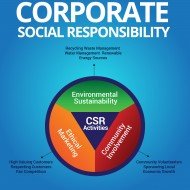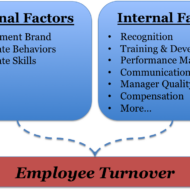Posted by Managementguru in Business Management, CSR, Entrepreneurship, Human Resource, Leadership, Strategy
on Dec 4th, 2014 | 0 comments

Does Your Company Have What It Takes to be A Leader? Corporations that are considered leaders in terms of business performance take a common approach to CSR. The blueprint for how corporations can maximize their investments in CSR contain five essential ingredients- Business-based social purposeClear theory of changeQuality and depth of informationConcentrated effort, andPartnering with experts. 1. Business-based social purpose: There have been too many examples of CSR programs that ignore business fundamentals. Leadership-level CSR programs always directly reflect what the business is and what it does. An “innovative CSR initiative” can emphasize the company’s business purpose and flawlessly leverage its operational competencies. The social purpose of a business is aligned with and supports social issues in a way that is consistent with the unique culture and character of the business. Srinivasan Services Trust is a social arm of Sundaram Clayton Limited and TVS Motor company established in 1996 for charitable purposes. The company focuses on improving health, education, women’s empowerment, infrastructure and environment that would bring about changes in the lives of people in a community. 2. Clear theory of change: CSR is becoming indispensable. On the one hand, that’s good news because it proves its business value. On the other hand, it’s getting harder to discriminate one company’s efforts from another’s. CSR leaders develop branded approaches to drive measurable social change. Starbucks Coffee has 8,000 stores, in 34 countries that sell to 30 million customers each week has adopted an unique CSR approach. Their mission is to provide the highest quality coffee in an environment that is consistent worldwide and support the sustainability of their farmers. Starbucks could be considered compliant and even proactive in their responsibilities to stakeholders. They purchase coffee in 20-30 countries per year, as their buying agents spend 240/365 days per year on the road searching for the best coffee farms and developing relationships with customers. It involves mutually agreed upon fair pricing, economic transparency, socially responsible buying, and environmentally friendly expectations. These standards protect the farmer’s business and ensure that Starbucks can support their ethical branding with practices that respect the environment. 3. Quality and Depth of Information: Merely pin-pointing social priorities for community investment is not adequate. Leadership comes from providing employees, customers and external stakeholders with a significant depth of information about the social issue through authentic research, white papers, videos, stories, social media, and so on. Bill & Melinda Gates Foundation or the Gates Foundation is one of the largest private foundations in the world, founded by Bill and Melinda Gates. It was launched in 2000 and is said to be the largest transparently operated private foundation in the world. Guided by the belief that ‘all lives have equal value’, Bill Gates and his wife Melinda Gates the co-chairs explain about their work and their commitment in supporting the government in reaching India’s most vulnerable communities with the services they need to live healthy and productive lives. The Department of Biotechnology (DBT) under the Ministry of Science and Technology of the Government of India and the Bill & Melinda Gates Foundation in collaboration with India’s Biotechnology Industry Research Assistance Council (BIRAC) launched a call for proposals as part of Grand Challenges India to reinvent the toilet. The Department of Biotechnology and the Gates Foundation will each invest US$1 million to support Indian investigators to drive research, development, and production of the “next generation toilet.” 4. Concentrated effort: Leadership is shown by corporations that direct their efforts on one social issue and align all their internal and external resources with this issue. 5. Partnering With Experts: Leadership entails showing a high degree of credibility. This is best done through relationships with social issue experts and not-for-profit organizations. Starbucks hosted...

Posted by Managementguru in Business Management, Human Resource, Labor Management, Organisational behaviour, Principles of Management, Strategy
on Mar 18th, 2014 | 0 comments

Smart Retention Strategies: Before going into the details of how to handle attrition, the first thing you must understand and realize is this. Each person working for you will have different expectations, perspectives and demands about his job, work environment and compensation respectively. Right at the time of recruiting and selecting the employee, his ideas must be taken into consideration and then it becomes the prerogative of the management whether to hire the person for that particular job. So the first step will be the right person for the right job, giving due importance to the anticipation of the employee who is going to become a member of your business family. Udemy Best Sellers:New Manager Training in Essential SkillsLeadership: Practical Leadership Skills Need for Open Conversation: In case of a small firm or company, it is easy for the manager to have a one on one conversation with each employee to settle his score of grievances then and there. Managers must have an open conversation without room for any ambiguity in the minds of his workers. The manager should try to protect the interest of the employees by representing their demands to the management at the right time. Many employees quit their positions because they have a nagging feeling at the back of their minds that their immediate boss is not the right kind of person to whom they can look up to and ask for support. In big corporates it is not easy to go for a one on one approach. A unique corporate culture that Trains the employees to have an uniform approach to all the systems of routineLed by an effective leader who controls and monitors the behavior and attitude of the workersPossesses sound management practices that make the employees come out with their suggestions freely and induce them to participateProvides satisfactory compensationIncorporates an open door policy catering to the different needs of people and also to the different levels of management, will help the managers to have a healthy relationship with the employees. Human Wants and Needs: Human wants are unlimited and when one want is satisfied, we want more of the same or yet another of a higher order. Approach your workforce to satisfy their craving either in terms of compensation or recognition which will also help to retain your workforce to a greater extent. There should be room for growth, especially for entrepreneurial minds and minds that have parallel thinking. Pic Courtesy: CuteHR Self-Motivation is the Key: Although motivation brings cheer amongst your workforce, self-motivated employees produce better results. Job satisfaction is a relative term; it differs with individuals, some like challenges and some are easily satisfied with an increase in salary quotient. A comprehensive appraisal on the personality of your workforce will give you a clear picture of the IQ (Intelligence Quotient) and EI (Emotional Intelligence) range of your employees which helps in designating employees in the appropriate slots. Such human rationing saves you a lot of time, energy and money as the employees are guaranteed satisfaction in their jobs. Contracts and Agreements: Contracts and agreements bind the employees to the firm only legally. How is that going to help you in terms of productivity? If one of your employees is going to work with discontent, he becomes a problem source spreading the same kind of feeling to others working with him. So it is also necessary for the management to spot out these problem persons either to bring them back into the groove or fire them without any further delay. Rising costs of living and unemployment ratios are really of economic concern, but still we find employees just like that quitting...




